House of Saud
The House of Saud (Arabic: آل سعود, romanized: ʾĀl Suʿūd IPA: [ʔaːl sʊʕuːd]) is the ruling royal family of Saudi Arabia. It is composed of the descendants of Muhammad bin Saud, founder of the Emirate of Diriyah, known as the First Saudi state (1744–1818), and his brothers, though the ruling faction of the family is primarily led by the descendants of Ibn Saud, the modern founder of Saudi Arabia.[1] The most influential position of the royal family is the King of Saudi Arabia. The family in total is estimated to comprise some 15,000 members, however the majority of power, influence and wealth is possessed by a group of about 2,000 of them.[2][3]
| House of Saud آل سعود | |
|---|---|
| Royal house | |
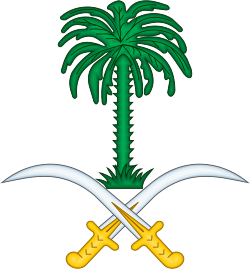 Emblem of Saudi Arabia, adopted in 1950 | |
| Parent family | Al-Muqrin of the Diriyah house of Al-Muraydi of Banu Hanifa |
| Country | Saudi Arabia |
| Founded | 1720 |
| Founder | Saud I (died 1725) |
| Current head | Salman bin Abdulaziz |
| Titles |
|
| Traditions | Sunni |
| Religion | Islam |
The House of Saud has had three phases: the Emirate of Diriyah, the First Saudi State (1744–1818), marked by the expansion of Wahhabism; the Emirate of Nejd, the Second Saudi State (1824–1891), marked with continuous infighting; and the Third Saudi State (1902–present), which evolved into Saudi Arabia in 1932 and now wields considerable influence in the Middle East. The family has had conflicts with the Ottoman Empire, the Sharif of Mecca, the Al Rashid family of Ha'il and their vassal houses in Najd, numerous Islamist groups both inside and outside Saudi Arabia and Shia minority in Saudi Arabia.
The succession to the Saudi Arabian throne was designed to pass from one son of the first king, Ibn Saud, to another. King Salman, who reigns currently, first replaced the next crown prince, his brother Muqrin, with his nephew Muhammad bin Nayef. In 2017, Muhammad bin Nayef was replaced by Mohammad bin Salman, King Salman's son, as the crown prince after an approval by the Allegiance Council with 31 out of 34 votes.[4][5][6][7][8][9] The monarchy was hereditary by agnatic seniority until 2006, when a royal decree provided that future Saudi kings are to be elected by a committee of Saudi princes.[10] The king-appointed cabinet includes more members of the royal family.
Title
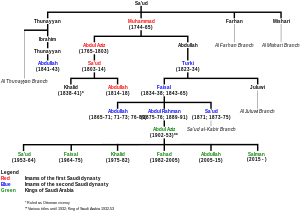
House of Saud is a translation of Al Saud, an Arabic dynastic name formed by adding the word Al (meaning "family of" or "House of")[11] to the personal name of an ancestor. In the case of the Al Saud, the ancestor is Saud ibn Muhammad ibn Muqrin, the father of the dynasty's 18th century founder Muhammad bin Saud (Muhammad, son of Saud).[12]
Today, the surname "Al Saud" is carried by any descendant of Muhammad bin Saud or his three brothers Farhan, Thunayyan, and Mishari. Al Saud's other family branches like Saud al-Kabir, the Al Jiluwi, the Al Thunayan, the Al Mishari and the Al Farhan are called cadet branches. Members of the cadet branches hold high and influential positions in government though they are not in the line of succession to the Saudi throne. Many cadet members intermarry within the Al Saud to reestablish their lineage and continue to wield influence in the government.[13][14]
All members of the royal family have the title of Emir (Prince) but sons, daughters, patrilineal granddaughters and grandsons of Kings are referred to by the style "His Royal Highness" (HRH), differing from patrilineal great-grandsons and members of cadet branches who are called "His Highness" (HH), while the reigning king uses the additional title of Custodian of the Two Holy Mosques.[13][14][15]
History
Origins and early history
The earliest recorded ancestor of the Al Saud was Mani' ibn Rabiah Al-Muraydi who settled in Diriyah in 1446–1447 with his clan, the Mrudah.[16] Although the Mrudah are believed to be descended from the Rabi'ah tribal confederation, the 'Anizza branches of the Rabi'ah.[16] Mani was invited by a relative named Ibn Dir. Ibn Dir was the ruler of a set of villages and estates that make up modern-day Riyadh.[17][18][19] Mani's clan had been on a sojourn in east Arabia, near al-Qatif, from an unknown point in time. Ibn Dir handed Mani two estates called al-Mulaybeed and Ghusayba. Mani and his family settled and renamed the region "al-Diriyah", after their benefactor Ibn Dir.[20][21]
The Mrudah became rulers of al-Diriyah, which prospered along the banks of Wadi Hanifa and became an important Najdi settlement. As the clan grew larger, power struggles ensued, with one branch leaving for nearby Dhruma, while another branch (the "Al Watban") left for the town of az-Zubayr in southern Iraq. The Al Muqrin became the ruling family among the Mrudah in Diriyah.
The name of the clan comes from Sheikh Saud ibn Muhammad ibn Muqrin who died in 1725.[22]
First Saudi state
The First Saudi State was founded in 1744. This period was marked by conquest of neighboring areas and by religious zeal. At its height, the First Saudi State included most of the territory of modern-day Saudi Arabia, and raids by Al Saud's allies and followers reached into Yemen, Oman, Syria, and Iraq. Islamic Scholars, particularly Muhammad ibn Abdul Wahhab and his descendants, are believed to have played a significant role in Saudi rule during this period. The Saudis and their allies referred to themselves during this period as the Muwahhidun or Ahl al-Tawhid ("the monotheists"). Later they were referred to as the Wahhabis, a group of particularly strict, puritanical Sunni sect, named for its founder.
Leadership of the Al Saud during the time of their first state passed from father to son without incident. The first imam, Muhammad ibn Saud, was succeeded by his eldest son Abdulaziz in 1765. In 1802, Abdulaziz led ten thousand Wahhabi soldiers into an attack on the Shi'ite holy city of Karbala, in what is now southern Iraq and where Hussein ibn Ali, the grandson of the prophet Muhammad is buried.[23] Led by Abdulaziz, the Wahhabi soldiers killed more than two thousand people, including women and children.[23] The soldiers plundered the city, demolishing the massive golden dome above Hussein's tomb and loaded hundreds of camels with weapons, jewelry, coins and other valuable goods.[23]
The attack on Karbala convinced the Ottomans and the Egyptians that the Saudis were a threat to regional peace.[24] Abdulaziz was killed in 1803 by an assassin, believed by some to have been a Shi'ite seeking revenge over the sacking of Karbala the year before. Abdul-Aziz was in turn succeeded by his son, Saud, under whose rule the Saudi state reached its greatest extent. By the time Saud died in 1814, his son and successor Abdullah ibn Saud had to contend with an Ottoman-Egyptian invasion in the Ottoman–Wahhabi War seeking to retake lost Ottoman Empire territory. The mainly Egyptian force succeeded in defeating Abdullah's forces, taking over the Saudi capital of Diriyyah in 1818. Abdullah was taken prisoner and was soon beheaded by the Ottomans in Constantinople, putting an end to the First Saudi State. The Egyptians sent many members of the Al Saud clan and other members of the local nobility as prisoners to Egypt and Constantinople, and razed the Saudi capital Diriyyah.
Second Saudi state
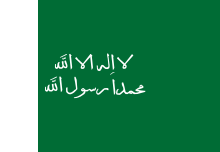
A few years after the fall of Diriyah in 1818, the Saudis were able to re-establish their authority in Najd, establishing the Emirate of Nejd, commonly known as the Second Saudi State, with its capital in Riyadh.
Compared to the First Saudi State, the second Saudi period was marked by less territorial expansion (it never reconquered the Hijaz or 'Asir, for example) and less religious zeal, although the Saudi leaders continued to go by the title of imam and still employed Salafi religious scholars. The second state was also marked by severe internal conflicts within the Saudi family, eventually leading to the dynasty's downfall. In all but one instance, succession occurred by assassination or civil war, the exception being the passage of authority from Faisal ibn Turki to his son Abdullah ibn Faisal ibn Turki.
Saudi Arabia
 |
|---|
| This article is part of a series on the politics and government of Saudi Arabia |
|
|
| Basic Law |
|
|
Administrative divisions
|
|
|
|
_on_14_February_1945_(USA-C-545).jpg)
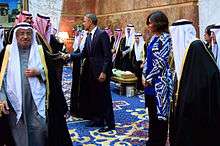
After his defeat at Mulayda, Abdul-Rahman ibn Faisal went with his family into exile in the deserts of eastern Arabia among the Al Murra bedouin. Soon afterward, however, he found refuge in Kuwait as a guest of the Kuwaiti emir, Mubarak Al Sabah. In 1902, Abdul-Rahman's son, Abdul Aziz, took on the task of restoring Saudi rule in Riyadh. Supported by a few dozen followers and accompanied by some of his brothers and relatives, Abdul Aziz was able to capture Riyadh's Masmak fort and kill the governor appointed there by Ibn Rashid. Abdul Aziz, reported to have been barely 20 at the time, was immediately proclaimed ruler in Riyadh. As the new leader of the House of Saud, Abdul Aziz became commonly known from that time onward as "Ibn Saud" in Western sources, though he is still called "Abdul Aziz" in the Arab world.
Ibn Saud spent the next three decades trying to re-establish his family's rule over central Arabia, starting with his native Najd. His chief rivals were the Al Rashid clan in Ha'il, the Sharifs of Mecca in the Hijaz, and the Ottoman Turks in al-Hasa. Ibn Saud also had to contend, however, with the descendants of his late uncle Saud ibn Faisal (later known as the "Saud al-Kabir" branch of the family), who posed as the rightful heirs to the throne. Though for a time acknowledging the sovereignty of the Ottoman Sultans and even taking the title of pasha, Ibn Saud allied himself to the British, in opposition to the Ottoman-backed Al Rashid. From 1915 to 1927, Ibn Saud's dominions were a protectorate of the British Empire, pursuant to the 1915 Treaty of Darin.
Ibn Saud won final victory over the Rashidis in 1921, making him the ruler of most of central Arabia. He consolidated his dominions as the Sultanate of Nejd. He then turned his attention to the Hijaz, finally conquering it in 1926, just months before the British protectorate ended. For the next five and a half years, he administered the two parts of his dual realm, the Kingdom of Hejaz and Nejd, as separate units.
By 1932, Ibn Saud had disposed of all his main rivals and consolidated his rule over much of the Arabian Peninsula. He united his dominions into the Kingdom of Saudi Arabia that year. Ibn Saud's father, Abdul Rahman retained the honorary title of "imam." In 1937 near Dammam, American surveyors discovered what later proved to be Saudi Arabia's vast oil reserves. Before the discovery of oil, many family members were destitute.[25]
Ibn Saud sired dozens of children by his many wives. He had at most four wives at a time, divorcing many times. He made sure to marry into many of the noble clans and tribes within his territory, including the chiefs of the Bani Khalid, Ajman, and Shammar tribes, as well as the Al ash-Sheikh (descendants of Muhammad ibn Abd al-Wahhab). He also arranged for his sons and relatives to enter into similar marriages. He appointed his eldest surviving son, Saud as heir apparent, to be succeeded by the next eldest son, Faisal. The Saudi family became known as the "royal family," and each member, male and female, was accorded the title amir ("prince") or amira ("princess"), respectively.
Ibn Saud died in 1953, after having cemented an alliance with the United States in 1945. He is still celebrated officially as the "Founder," and only his direct descendants may take on the title of "his or her Royal Highness." The date of his recapture of Riyadh in 1902 was chosen to mark Saudi Arabia's centennial in 1999 (according to the Islamic lunar calendar).
Upon Ibn Saud's death, his son Saud assumed the throne without incident, but his lavish spending led to a power struggle with his brother, Crown Prince Faisal. In 1964, the royal family forced Saud to abdicate in favor of Faisal, aided by an edict from the country's grand mufti. During this period, some of Ibn Saud's younger sons, led by Talal ibn Abdul Aziz, defected to Egypt, calling themselves the "Free Princes" and calling for liberalization and reform, but were later induced to return by Faisal. They were fully pardoned but were also barred from any future positions in government.
Faisal was assassinated in 1975 by a nephew, Faisal ibn Musaid, who was promptly executed. Another brother, Khalid, assumed the throne. The next prince in line had actually been Prince Muhammad, but he had relinquished his claim to the throne in favor of Khalid, his only full brother.
Khalid died of a heart attack in 1982, and was succeeded by Fahd, the eldest of the powerful "Sudairi Seven", so-called because they were all sons of Ibn Saud by his wife Hassa Al Sudairi. Fahd did away with the previous royal title of "his Majesty" and replaced it with the honorific "Custodian of the Two Holy Mosques", in reference to the two Islamic holy sites in Mecca and Medina, in 1986.
A stroke in 1995 left Fahd largely incapacitated. His half-brother, Crown Prince Abdullah [who was descended on the maternal side from the rival Rashidi] , gradually took over most of the king's responsibilities until Fahd's death in August 2005. Abdullah was proclaimed king on the day of Fahd's death and promptly appointed his younger brother, Sultan bin Abdulaziz, the minister of defense and Fahd's "Second Deputy Prime Minister," as the new heir apparent. On 27 March 2009, Abdullah appointed Prince Nayef Interior Minister as his "second deputy prime minister" and Crown Prince on 27 October.[26] Sultan died in October 2011 while Nayef died in Geneva, Switzerland on 15 June 2012. On 23 January 2015, Abdullah died after a prolonged illness, and his half-brother, Crown Prince Salman bin Abdulaziz Al Saud, was declared the new King.
Many princes and government officials have been arrested in the 2017 in alleged anti corruption campaign by the King and Crown prince. United States President Donald Trump has expressed support for the arrests.[27]
Political power
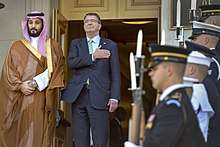
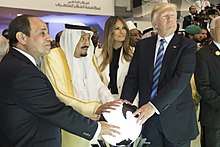
The head of the House of Saud is the King of Saudi Arabia who serves as Head of State and monarch of the Kingdom of Saudi Arabia. The King holds almost absolute political power. The King appoints ministers to his cabinet who supervise their respective ministries in his name. The key ministries of Defence, the Interior and Foreign Affairs are usually held by members of the Saud family, as are most of the thirteen regional governorships. Most portfolios, however, such as Finance, Labour, Information, Planning, Petroleum Affairs and Industry, have traditionally been given to commoners, often with junior Al Saud members serving as their deputies. House of Saud family members also hold many of the Kingdom's critical military and governmental departmental posts. Ultimate power in the Kingdom has always rested upon the Al Saud, though support from the Ulema, the merchant community, and the population at large has been key to the maintenance of the royal family's political status quo.
Long-term political and government appointments have occurred, such as those of King Faisal, who was Foreign Minister almost continuously from 1932 to 1975, King Abdullah, who was Commander of the National Guard from 1963 to 2010, and former Crown prince Sultan bin Abdulaziz, who was Minister of Defence and Aviation from 1962 until his death in 2011. Such terms of service have enabled senior princes to mingle their personal wealth with that of their respective domains. They have often appointed their own sons to senior positions within their own fiefdom. Examples of these include Prince Mutaib bin Abdullah as assistant commander in the National Guard until 2010; Prince Khalid bin Sultan as assistant minister of defence until 2013; Prince Mansour bin Mutaib as assistant minister for Municipal and Rural Affairs until he replaced his father in 2009; and Prince Mohammed bin Nayef as assistant minister in the Interior Ministry. In cases, where portfolios have notably substantial budgets, appointments of younger, often full, brothers have been necessary, as deputies or vice ministers, ostensibly to share the wealth and the burdens of responsibility, of each fiefdom. Examples of these include Prince Abdul Rahman who was vice minister of defence and aviation under Prince Sultan; Prince Badr, deputy to King Abdullah in the National Guard; Prince Sattam, who was Deputy Riyadh Governor during King Salman's term; and Prince Ahmed, who held the deputy minister's portfolio under Prince Nayef's interior ministry.
Unlike Western royal families, the Saudi Monarchy has not had a clearly defined order of succession. Historically, upon becoming King, the monarch has designated an heir apparent to the throne who serves as Crown Prince of the Kingdom. Upon the King's death the Crown Prince becomes King, and during the King's incapacitation the Crown Prince, likewise, assumes power as regent. Although other members of the Al Saud hold political positions in the Saudi government, it is only the King and Crown Prince who legally constitute the political institutions.
Succession
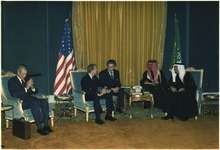
Succession has been from brother to brother since the death of the founder of modern Saudi Arabia. Ibn Saud was succeeded by his son Saud. Saud was succeeded by his brother Faisal. Faisal was succeeded by his brother Khalid who, in turn, was succeeded by his brother Fahd. Fahd was succeeded by his brother Abdullah, and Abdullah by his brother Salman, the current King. Salman appointed his half-brother Muqrin as Crown Prince in January 2015 and removed him in April 2015. Even Abdulaziz's youngest son was to turn 70 in 2015. Abdulaziz, in 1920, had said that the further succession would be from brother to brother, not from father to son.
.jpg)
King Salman ended the brother-to-brother succession and appointed his 56-year-old nephew Muhammad bin Nayef as Crown Prince in April 2015, thus making the next succession from uncle to nephew. At the same time, King Salman appointed his son, Mohammad bin Salman, as Deputy Crown Prince, thus making the following succession from cousin to cousin, as Mohammad bin Salman is the cousin of Crown Prince Muhammad bin Nayef. However, in June 2017, Salman elevated Mohammad bin Salman to Crown Prince, following his decision to depose Muhammad bin Nayef of all positions, making his son heir apparent to the throne, and making the next succession father to son, for the first time since 1953, when Saud bin Abdulaziz Al Saud succeeded his father, the founder of Saudi Arabia, Ibn Saud.[7][8][9]
Amid international outcry over the killing of Jamal Khashoggi, members of Saudi's royal families are distressed over the Crown Prince Mohammad bin Salman becoming the next king. A lot of princes and members of the Al Saud family want Prince Ahmed to become the next king instead of MbS. During his London tour, Prince Ahmed criticized the Saudi leadership. He was also the only member of the ruling family to oppose MbS from becoming the crown prince in 2017.[28]
Wealth
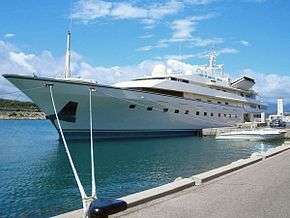
In June 2015 Forbes listed Prince Al-Waleed bin Talal as the 34th-richest man in the world, with an estimated net worth of US$22.6 billion.[29] Prince Al-Waleed had a net worth of $20.4 billion in 2014.[30] By 2016, according to the TeleSUR, King Salman "net worth was estimated at US$17.0 billion".[31]
As of 2020 the combined net worth of the entire royal family has been estimated at around $100 billion which makes them the richest royal family among all monarchs as well as one of the wealthiest families in the world.[32]
Opposition
Due to its authoritarian and quasi-theocratic rule, the House of Saud has attracted much criticism during its rule of Saudi Arabia. There have been numerous incidents, including the Wahhabi Ikhwan militia uprising during the reign of Ibn Saud. Osama Bin Laden, a critic of the US, was a critic of Saudi Arabia and was denaturalized in the mid 1990s.[33]
On 20 November 1979, the Grand Mosque seizure saw the al-Masjid al-Haram in Mecca violently seized by a group of 500 heavily armed and provisioned Saudi dissidents led by Juhayman al-Otaybi and Abdullah al-Qahtani,[34] consisting mostly of members of the former Ikhwan militia of Otaibah[35] but also of other peninsular Arabs and a few Egyptians enrolled in Islamic studies at the Islamic University of Madinah. The Saudi royal family turned to the Ulema who duly issued a fatwa permitting the storming of the holy sanctuary by Saudi forces, aided by French and Pakistani special ops units.[36] According to Lawrence Wright, the GIGN commandos did convert to Islam.[37] Most of those responsible, including Al-Otaybi himself, were beheaded publicly in four cities of Saudi Arabia.[38]
In January 2016, Saudi Arabia executed the prominent Shiite cleric Sheikh Nimr, who had called for pro-democracy demonstrations, along with forty-seven other Saudi Shia citizens sentenced by the Specialized Criminal Court on terrorism charges.[39]
Since May 2017 in response to protests against the government, the predominantly Shia town of Al-Awamiyah has been put under full siege by the Saudi military. Residents are not allowed to enter or leave, and military indiscriminately shells the neighborhoods with airstrikes, mortar[40] and artillery[41] fire along with snipers[42] shooting residents.[43][44][45][46] Dozens of Shia civilians were killed, including a three year old and[47] a two-year-old child.[48][49] The Saudi government claims it is fighting terrorists in al-Awamiyah.
Crown Prince Mohammed bin Salman kept his own mother away from his father for more than two years, out of the fear that she would stop the king from giving the power to him. Princess Fahda bint Falah Al Hathleen, third wife of King Salman, was said to be in America for medical treatment. However, according to American intelligence this was refuted stating that she was not in the country.[50]
Some Royals have been criticised for various Human Rights violations, including the death of Jamal Khashoggi, treatment of workers [51] and the Yemen war.
The Reuters reported on 23 June, 2020, Saudi Crown Prince Mohammed bin Salman of allegedly threatening and intimidating a former intelligence officer, Saad al-Jabri along with his family of adult children, of returning to Saudi Arabia from exile in Canada. Saad was a long-time aide to the former crown prince, Prince Mohammed bin Nayef, who Prince Salman ousted in 2017. The official allegedly has access to documents containing information sensitive and pivotal for the crown prince’s leadership.[52]
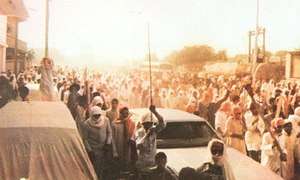 Demonstrators in Eastern Province during the 1979 Qatif Uprising
Demonstrators in Eastern Province during the 1979 Qatif Uprising.jpg) Jamal Khashoggi was murdered by Saudis in Turkey, because of his opposition to the government
Jamal Khashoggi was murdered by Saudis in Turkey, because of his opposition to the government
Heads
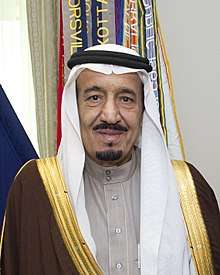
First Saudi state
- Muhammad ibn Saud (approx. 1710[53]−1765) ruled 1744–1765
- Abdul-Aziz ibn Muhammad ibn Saud (died 1803) ruled 1765–1803
- Saud ibn Abdul-Aziz ibn Muhammad Al Saud (died 1814) ruled 1803–1814
- Abdullah ibn Saud (died 1818) ruled 1814–1818
Second Saudi state
- 1. Turki ibn Abdallah (1755–1834) ruled 1824[54]−1834
- 2 and 5. Faisal ibn Turki Al Saud (1785–1865) ruled 1834–1838 and 1843–1865. Son of Turki
- 3. Khalid bin Saud ibn Abdul-Aziz ibn Muhammad ibn Saud ruled 1838–1841. Distant cousin
- 4. Abdullah ibn Thunayyan ruled 1841–1843. Distant cousin
- 6, 8, and 11. Abdullah bin Faisal bin Turki Al Saud ruled 1865–1871, 1871–1873, 1876–1889. Son of Faisal
- 7 and 9. Saud ibn Faisal ibn Turki (died 1875) ruled 1871 and 1873–1875. Son of Faisal
- 10 and 12. Abdul-Rahman bin Faisal (1850–1928) ruled 1875–1876 and 1889–1891. Son of Faisal
Kingdom of Saudi Arabia
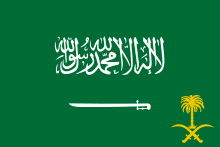
- Abdulaziz bin Abdul-Rahman bin Faisal known as Ibn Saud (15 January 1876 – 9 November 1953) ruled 1902[55]–1953
- King Saud bin Abdulaziz (15 January 1902 – 24 January 1969) ruled 1953–1964
- King Faisal bin Abdulaziz (April 1906 – 25 March 1975) ruled 1964–1975
- King Khalid bin Abdulaziz (13 February 1913 – 13 June 1982) ruled 1975–1982
- King Fahd bin Abdulaziz (16 March 1920 – 1 August 2005) ruled 1982–2005
- King Abdullah bin Abdulaziz (1 August 1924 – 23 January 2015) ruled 2005–2015
- King Salman bin Abdulaziz (born 31 December 1935) since 2015
Most notable current members
Sons of King Abdulaziz
The list of King Abdulaziz's surviving sons, except for current Saudi monarch Salman, are as follows:
- Abdul llah bin Abdulaziz (born 1939) – Former governor of Al Jawf Province. He was special advisor to King Abdullah from 2008 to 2015.
- Mamdouh bin Abdulaziz (born 1940) – Former governor of Tabuk region who was removed from the post by King Fahd for insubordination. Later he was made director of Saudi Center of Strategic Studies.
- Ahmed bin Abdulaziz (born 1942) – Deputy minister of interior from 1975 to 2012; minister of interior from June 2012 to 5 November 2012.
- Mashhur bin Abdulaziz (born 1942)
- Muqrin bin Abdulaziz Al Saud (born 1945) – Director general of the General Intelligence Directorate from 2005 to 2012; former governor of Ha'il and Madinah provinces. He was appointed second deputy prime minister on 1 February 2013 and he was made crown prince on 23 January 2015 when his half-brother Salman became king. On 28 April 2015 Muqrin was granted resignation based on his request to start the next generation of the royals.
Genealogy
See also
- 2017 Saudi Arabian purge
- Al ash-Sheikh
- Bani Hareth
- Bani Yas
- Banu Thaqif
- Banu Yam
- Bedouin
- Death of a Princess
- King of Saudi Arabia
- Saudi Royal Guard Regiment
References
- "The House of Al Saud – A View of the Modern Saudi Dynasty". Frontline. PBS. 18 September 2015.
- "HRH Princess Basma bint Saud bin Abdulaziz Al Saud". Hardtalk. BBC. 28 July 2011. Retrieved 7 April 2013.
- Milmo Cahal (3 January 2012). "The Acton princess leading the fight for Saudi freedom". The Independent. Retrieved 3 January 2012.
- Chulov, Martin; Borger, Julian (21 June 2017). "Saudi king ousts nephew to name son as first in line to throne". The Guardian. ISSN 0261-3077. Retrieved 3 September 2019.
- "Mohammed bin Salman becomes Saudi Crown Prince with 31 out of 34 votes". Al Arabiya. Retrieved 3 September 2019.
- Al-awsat, Asharq. "Middle-east Arab News Opinion". Asharq Al-Awsat. London. Retrieved 3 September 2019.
- Nicole Chavez, Tamara Qiblawi and James Griffiths. "Saudi Arabia's king replaces nephew with son as heir to throne". CNN.
- Raghavan, Sudarsan; Fahim, Kareem (21 June 2017). "Saudi king names son as new crown prince, upending the royal succession line". The Washington Post. Retrieved 21 June 2017.
- "Saudi royal decrees announcing Prince Mohammed BinSalman as the new crown prince". The National. Abu Dhabi. Retrieved 21 June 2017.
- Dewey, Caitlin; Max Fisher (22 July 2013). "Meet the world's other 25 royal families". The Washington Post. Retrieved 5 May 2020.
- Wynbrandt, James; Gerges Fawaz A. (2010). A Brief History of Saudi Arabia. p. xvii. ISBN 978-0-8160-7876-9.
- Wahbi Hariri-Rifai; Mokhless Hariri-Rifai (1990). The heritage of the Kingdom of Saudi Arabia. p. 26. ISBN 978-0-9624483-0-0.
- Amos, Deborah (1991). "Sheikh to Chic". Mother Jones. p. 28. Retrieved 12 July 2016.
- "Saudi Arabia: HRH or HH? – American Bedu". 7 August 2016. Archived from the original on 7 August 2016.CS1 maint: BOT: original-url status unknown (link)
- "Family Tree". www.datarabia.com. Retrieved 7 December 2016.
- Stig Stenslie (21 August 2012). Regime Stability in Saudi Arabia: The Challenge of Succession. Routledge. p. 53. ISBN 978-1-136-51157-8.
- Counter-Narratives: History, Contemporary Society, and Politics in Saudi Arabia and Yemen by Madawi Al-Rasheed (Editor), Robert Vitalis (Editor) p. 64
- "History of the Kingdom". Ministry of Foreign Affairs. Retrieved 20 March 2015.
- "Al Saud Family Saudi Arabia History". Arab Royal Family. Retrieved 20 March 2015.
- G. Rentz (2007). "al- Diriyya (or al-Dariyya)". In P. Bearman; Th. Bianquis; C.E. Bosworth; E. van Donzel; W.P. Heinrichs (eds.). Encyclopaedia of Islam. Brill. Retrieved 8 September 2007.
- H. St. John Philby (1955). Saudi Arabia. London: Ernest Benn. p. 8.
- John Pike. "King Abdul Aziz Bin Abdul Rahman Al-Saud". Global Security. Retrieved 20 March 2015.
- Mark Weston (2008). Prophets and princes: Saudi Arabia from Muhammad to the present. Hoboken, N.J.: Wiley. p. 101. ISBN 978-0470182574.
- Wayne H. Bowen (2008). The history of Saudi Arabia (1. publ. ed.). Westport, Conn.: Greenwood Press. p. 73. ISBN 978-0313340123.
- Abdullah Mohammad Sindi (16 January 2004). "Britain and the Rise of Islam and the House of Saud". Kana'an Bulletin. IV (361): 7–8.
- "Saudi Arabia names Prince Nayef as heir to throne". BBC. 27 October 2011. Retrieved 28 October 2011.
- "Saudi princes, ministers and tycoons arrested in sweeping purge".
- "After Khashoggi murder, some Saudi royals turn against crown prince". CNBC. Retrieved 20 November 2018.
- "The World's Billionaires". Forbes. Retrieved 2 July 2015.
- "Meet The Richest People In The Middle East". Forbes. 24 March 2014.
- "Saudi King, UAE President at the Center of the Panama Papers". TeleSUR. 4 April 2016.
- https://www.investopedia.com/articles/insights/052416/top-10-wealthiest-families-world.asp
- "From Millionaire's Son To Most-Wanted".
- J.A. Kechichican (1990). "Islamic Revivalism and Change in Saudi Arabia: Juhayman al-'Utaybi's 'Letters to the Saudi People'". The Muslim World. 50: 1–16. doi:10.1111/j.1478-1913.1990.tb03478.x.
- Joseph Kostiner (8 July 1997). "State, Islam and Opposition in Saudi Arabia: The Post Desert-Storm Phase". The Middle East Review of International Affairs (MERIA). 1 (2). Archived from the original on 21 June 2013. Retrieved 9 November 2012.
- Yaroslav Trofimov (22 September 2007). "Did 'Siege of Mecca' Give Birth to Al-Qaida?" (Interview). Interviewed by Jacki Lyden. NPR (National Public Radio).
- Wright Lawrence (2006). The Looming Tower: Al-Qaeda and the Road to 9/11 (1st ed.). Alfred A. Knopf (US). p. 110. ISBN 978-0141029351. Retrieved 25 January 2014.
- "Mecca". Global Security. 9 July 2011. Retrieved 29 December 2006.
- "Saudi execution of Shia cleric sparks outrage in Middle East". The Guardian. 2 January 2016.
- ABNA24 (31 July 2017). "ABWA's satement on condemnation of Al Saud's crimes in Awamiyah".
- ABNA24, PressTV (26 July 2017). "Saudi forces shell homes in Awamiyah, Two killed / Video & Pics".
- "Snipers Injure Scores of Civilians in Saudi Arabia's Qatif". 14 June 2017.
- "PressTV-Saudi forces shot dead youth in restive Qatif".
- "PressTV-Saudi regime offensive on Shia town enters week 2".
- "'You might get shot any time': Saudi forces raid Shia town as Riyadh welcomes Trump". RT.
- "Saudi Shia-Muslim town under 'siege' for sixth day". 15 May 2017.
- "Three-year-old dies from wounds after Saudi security forces 'open fire on family'". 10 August 2017.
- "PressTV-Saudi forces kill toddler, young man in Qatif". Press TV. 12 May 2017.
- "Saudi Forces Raid Al-Masoura in Awamiyah, Open Fire, Destroy Houses". Al-Manar.
- "Saudi Crown Prince Mohammed bin Salman 'has hidden away his own mother'". The Telegraph. Retrieved 15 March 2018.
- https://www.france24.com/en/20190613-sister-saudi-crown-prince-faces-paris-trial-over-attack-workman
- "Saudi leadership pressures former intelligence official's family, seeks access to documents". Reuters. Retrieved 23 June 2020.
- "Timeline Saudi Arabia". Retrieved 25 June 2012.
- Turki ibn Abdallah ruled various parts of the area between 1819 and 1824. The Second Saudi State was officially founded in 1824.
- Abdul-Aziz ruled various parts of the area between 1902 and 1932. The Kingdom was officially founded in 1932.
- James Wynbrandt (2010). A Brief History of Saudi Arabia (berilustrasi ed.). Infobase Publishing. p. 107. ISBN 0-8160-7876-9, 9780816078769.
Further reading
- Madawi Al-Rasheed, A History of Saudi Arabia, Cambridge University Press, 2002, ISBN 0-521-64412-7
- David Fromkin, A Peace to End All Peace, Holt, 1989, ISBN 978-0-8050-8809-0.
- David Holden & Richard Johns, The House of Saud, Pan, 1982, 0-330-26834-1 (reprint of the Sidgwick and Jackson edition, 1981, ISBN 0-283-98436-8)
- Craig Unger, House of Bush, House of Saud: The Secret Relationship Between the World's Two Most Powerful Dynasties, Scribner, 2004, ISBN 0-7432-5337-X
- Alexei Vassiliev, The History of Saudi Arabia, London, UK: Al Saqi Books, 1998
External links
| Wikiquote has quotations related to: House of Saud |
- A Chronology: The House of Saud, Frontline, PBS (Public Broadcasting Service), 1 August 2005
- The House of Saud: A View of the Modern Saudi Dynasty, Frontline, PBS (Public Broadcasting Service), 1 August 2005
- Structure of the House of Saud (PDF), GlobalSecurity.org
- "Saudi Royal Family Directory". Datarabia.
- "Saudi Royal Family Website". House of Saud.